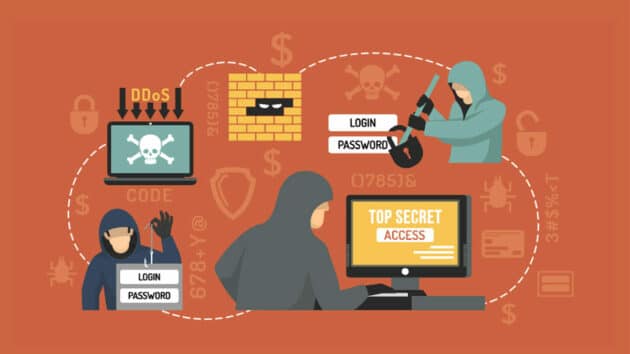Cybersecurity is a familiar word but cyber threat intelligence and its relation to cybersecurity may not be a familiar concept to many of us.
From fishing expeditions to ransomware, things got even worse by unleashing an avalanche of cyber-attacks, especially during this pandemic. Institutions have reported an increase of 91% in cyber security attacks, which is a conservative figure.
As the workload increased, it became difficult for the cyber specialists and teams to focus everywhere at once. This is where cyber threat intelligence plays an important role in powering up cyber security. Let us discuss more it in detail.
What is cyber threat intelligence?

Cyber threat intelligence is a force multiplier that facilitates the needs of organizations to update their response and detection programs to deal with continuously increasing innovative threats.
Though malware is a commonly used tool by an adversary, humans are the real threat, and cyber threat intelligence focuses on dealing with flexible and continuous human threats using authorized and trained human defenders. An organization needs a leading, high-level threat-hunting or event response team during targeted cyber-attacks to understand how opponents are acting and how to deal with the threat.
In addition, cyber threat intelligence integrates the universal functions of intelligence.
Recommended for you: 5 Fantastic Programming Languages Best for Cybersecurity.
What is the significance of cyber threat intelligence?

Nowadays, data rules the world, and everyone keeps their sensitive information on their interconnected devices. Although adequate security measures are taken by various systems and devices, often data breaches happen due to the vulnerability of the devices.
Larger organizations have to be very concerned about this aspect as have a huge workforce and many departments. So, in such organizations, the IT team may belatedly be known of any cyber-attack in any department. This scenario forces us to think of cyber threat intelligence and its inevitability to mitigate any data breach.
Biggest cyber threats

Amid the increase in remote work, cloud migration, and advanced cyber hackers/attackers cyber threats have become more complicated and intense. Here is the list of some biggest cyber threats:
1. Social engineering
Phishing emails, scareware, and quid pro quo are some of the social engineering attacks that are capable of manipulating human psychology thereby forcing them to acquire certain goals.
2. Ransomware
Ransomware is a data-encoded program that seeks payment to release infected data. The total amount of ransom has reached $1.4 billion by 2020, and the average amount to repair the damage was $1.45 million. It is used in 22% of cases and is considered the third most popular malware used in breaching data.
3. DDoS attacks
Hackers use previously hacked or malware-installed devices to create a botnet for a unified DDoS attack. This may result in machines performing unethical or criminal activities with the owner being unaware. That is not the only problem faced by cybersecurity experts, attackers are using Artificial Intelligence (AI) to carry out DDoS attacks.
4. Third-party software
If an application in this habitat is compromised, it opens a door for hackers to other domains. Violations by a third party can cost an average of $4.29 million. As per the reports, web applications were indulged in 43% of breaches and 80% of organizations have dealt with a cybersecurity violation as a result of the vulnerability in their third-party vendor environment.
5. Cloud computing vulnerabilities
To gain access to the user’s account hackers scan for cloud servers without a password, take advantage of unpatched systems and use brutal force The motive is to use cloud systems for crypto-jacking or integrated DDoS attacks, to install ransomware, or to steal sensitive data.
Biggest sources of cyber threats

It is very important to have an idea about the threat actor and understand the tactics, techniques, and procedures (TTP) related to them when identifying a cyber threat. The sources of cyber threat intelligence have not changed while the TTP of adversaries is continuously changing to avoid detection.
Usually, there is a human element, someone who falls into a clever strategy. But most importantly, there will be a motive always and that is the actual source of cyber threats. Understanding offensive TTP allows you to identify the purpose of a cyber threat and take action to prevent further steps.
Some of the common sources of cyber threat include:
- Groups of hackers.
- Malicious Intruders.
- Corporate Spies.
- The Nation States.
- Groups of terrorists.
- Hacktivists.
You may like: How to Protect Your PC from Cyber-attacks, Tracking, & Malware?
What are the different types of cyber threat intelligence?

There are four levels of cyber threat intelligence: Strategic threat intelligence, Tactical threat Intelligence, Technical threat intelligence, and Operational threat intelligence.
A. Strategic threat intelligence
Strategic intelligence provides a broad level of information on the cyber threats which organizations face. It is more of a less technical nature which helps the top leaders and management of the organizations to derive the right strategy based on the reports given through strategic threat intelligence.
In fact, it offers a clear-cut outline of the cyber landscape, the latest trends in the cyber world, and its financial impact on the entity. So, the decision-making could be more appropriate, and preventive measures could be taken by identifying the potential threats with the support of strategic threat intelligence.
B. Tactical threat intelligence
Tactical threat intelligence provides certain information on the attackers’ tactics, techniques, and procedures which helps security analysts to track the course of the attack. It offers the security team a better perception to formulate a deterrent strategy in the event of any cyber-attacks.
The reports of tactical threat intelligence point out the loopholes in the security apparatus that are vulnerable to attacks and how to detect any breach of security.
C. Technical threat intelligence
Technical threat intelligence primarily deals with distinct proof of an imminent cyber-attack and formulates a base to examine it. It detects indicators of compromise (IOC) such as fraudulent URLs, phishing emails, malware content, etc.
The response time of the technical threat intelligence is crucial as these IPs and URLs would no longer be in use within a few days.
D. Operational threat intelligence
Operational Threat intelligence focuses on the information of cyber hackers and their intentions. This information on cyberattacks in detail enables the IT team of an organization to know the exact nature of the data breach. Here, you collect the information of the hackers and their intent by infiltrating their chatroom rooms.
How to enhance your cyber security using cyber threat intelligence?

Extensive threat actors including organized cybercriminals, national states, and corporate spies are the biggest information security threat to today’s ventures. Many institutions face difficulty in detecting these threats due to their secretive nature, resource complexity, and lack of deep understanding of the behavior of the threat actor.
Knowledge of the opponent is central to all security teams. The Red team (the team of security professionals) needs to analyze and understand the methods used by the opponents in order to copy their tradecraft (the techniques, methodologies, and technology).
- The Security Operations Center should have clear knowledge about how to hierarchize intrusions and how to manage quickly those in need of immediate attention.
- The incident response team requires functional information to give a rapid response to targeted intrusions.
- The vulnerability management group needs to understand that each damage is important for determining the priority and the risk involved in each damage.
- The threat-hunting team needs to understand the behavior of the opponents to look for new threats.
Moreover, each cyber threat intelligence analyst should analyze and understand certain factors regarding the threat and adversaries.
Here are some of the questions every analyst should keep in mind:
- Who are the adversaries?
- What is the motive behind the attack?
- Which tradecraft they are using?
- How do they operate?
- When will the attack happen?
In short, cyber threat intelligence appraises every security method that deals with opponents. Cyber threat intelligence provides tactical, functional, and strategic skills, and tradecraft to the institution and the security team to better understand the geography of the threat and deal with those threats effectively.
Below are some steps involved in the strong cyber threat intelligence process:
- Consolidate: collect necessary intelligence to acquire a sole overview of the field of threat.
- Contextualize: analyze and get an idea about the threat and the danger it brings to your organization.
- Prioritize: concentrate on the threat that needs to be given more attention.
- Implement: bring the prioritized threat into action that alleviates the danger.
- Enhance: constantly update threat intelligence to keep a distance ahead of cyber attackers.
You may also like: What is the Role of Artificial Intelligence (AI) in Cybersecurity?
Conclusion

Do you know what is the most powerful tool in the hands of a cyber threat analyst? It is threat intelligence that can give necessary information at every level of the security program. It ranges from security analysts who respond to tactical threats to the executives who report the threat to the Board of Directors.
The purpose of this article is to understand the role of threat intelligence in security operations and how it can be used as a game-changing resource to deal with increasingly complex adversaries and threats.
Author: Mubarak Musthafa

This article is written by Mubarak Musthafa. Mubarak is the Vice President of Technology & Services at ClaySys Technologies.





